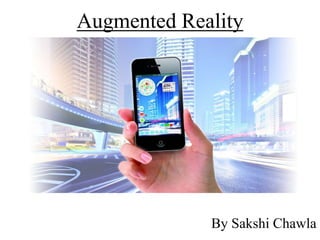Augmented reality
- 1. Augmented Reality By Sakshi Chawla
- 2. What is Augmented Reality? Augmented reality is a type of virtual reality that aims to duplicate the worldâs environment in a computer. An augmented reality system generates a composite view for the user that is the combination of the real scene viewed by the user and a virtual scene generated by the computer.
- 3. Technology âĒ Hardware ïProcessors ïDisplay ïSensors ïInput devices âĒ Software & Algorithms
- 4. Hardware Hardware components for augmented reality are : processors, display , sensors and input devices. Modern mobile computing devices like smart phones and tablet computers contains these elements which often include a camera and MEMS sensors such as accelerometer, GPS, and solid state compass, making them suitable AR platforms.
- 5. Display Various technologies are used in Augmented Reality systems rendering including optical projection systems, monitors, hand held devices, and display systems worn on oneâs person. Head-mounted *A head-mounted display (HMD) is a display device paired to a headset such as a harness or helmet. *HMDs place image of both physical world and virtual world over the userâs field of view. *Modern HMDs often employ sensors for six degrees of freedom monitoring that allow the system to align virtual information to physical world and adjust accordingly with userâs head movements.
- 7. Eyeglasses AR displays can be rendered on devices resembling eyeglasses. Versions include eyewear that employ cameras to intercept the real world view and re-display its augmented view through the eye pieces. Contact lenses that display AR imaging are in development.
- 8. Handheld âĒ Handheld display employs a small display that fits in a user's hand. âĒ The two main advantages of handheld AR is the portable nature of handheld devices and ubiquitous nature of camera phones. Spatial Spatial Augmented Reality (SAR) augments real world objects and scenes without the use of special displays such as monitors, head mounted displays or hand-held devices. SAR makes use of digital projectors to display graphical information onto physical objects.
- 9. Tracking Modern mobile augmented reality systems use one or more of the following tracking technologies: digital cameras and/or other optical sensors, accelerometers, GPS, solid state compasses.
- 10. Software And Algorithm A key measure of AR systems is how realistically they integrate augmentations with the real world. The software must derive real world coordinates, independent from the camera, from camera images. Many computer vision methods of augmented reality are inherited from visual odometry. Usually those methods consist of two parts. âĒ First detect interest points, or fiducial markers, or optical flow in the camera images. âĒ The second stage restores a real world coordinate system from the data obtained in the first stage.
- 11. âĒ Augmented Reality Markup Language (ARML) is a data standard developed within the Open Geospatial Consortium (OGC), which consists of an XML grammar to describe the location and appearance of virtual objects in the scene, as well as ECMA Script bindings to allow dynamic access to properties of virtual objects. âĒ To enable rapid development of Augmented Reality Application, some software development kits (SDK) have emerged. A few SDK such as CloudRidAR leverage cloud computing for performance improvement. Some of the well known AR SDKs are offered by Metaio, Vuforia, Mobinett AR, Wikitude, Blippar and Layar.
- 12. Applications Augmented reality has many applications. First used for military, industrial, and medical applications, it has also been applied to commercial, educational and entertainment areas.
- 13. Military AR can serve as a networked communication system that renders useful battlefield data onto a soldier's goggles in real time.
- 14. Medical Augmented Reality can provide the surgeon with information, which are otherwise hidden, such as showing the heartbeat rate, the blood pressure, the state of the patientâs organ, etc. AR can be used to let a doctor look inside a patient by combining one source of images such as an X-ray with another such as video.
- 15. Education Augmented reality applications can complement a standard curriculum. Text, graphics, video and audio can be superimposed into a studentâs real time environment.
- 16. Gaming And Entertainment Augmented reality allows gamers to experience digital game play in a real world environment. Sports and entertainment venues are provided with see-through and overlay augmentation through tracked camera feeds for enhanced viewing by the audience.
- 17. Advantages âĒ Live Implications âĒ Improved Interaction âĒ Personal Experience âĒ Military, educational, medical and video game applications.
- 18. Disadvantages âĒ People are missing out whatâs right in front of them âĒ Lack of privacy âĒ Expensive to develop and maintain
- 19. Thank You


















